Steve Mann
Prior Art: Art of Record for Personal Safety
Curated by Kathleen Pirrie Adams
Opening Thursday 2001 Jul 5, 7pm,
on display until 2001 Jul 28.
Gallery TPW, 80 Spadina Ave., Toronto.
Admission is free. (Free of cost, as well as Anthrax-free.)
In and around the entranceway
some clothing (Mann's wearable computer inventions)
is on exhibit. This is the only place in the facility
where clothing will be allowed:
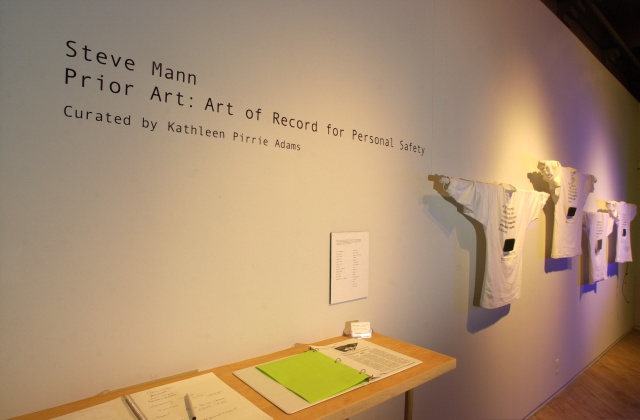
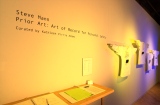
Into the next room, a
recently constructed mass
decontamination facility is shown in a partially constructed state,
so that we can see around it, and understand how it works:
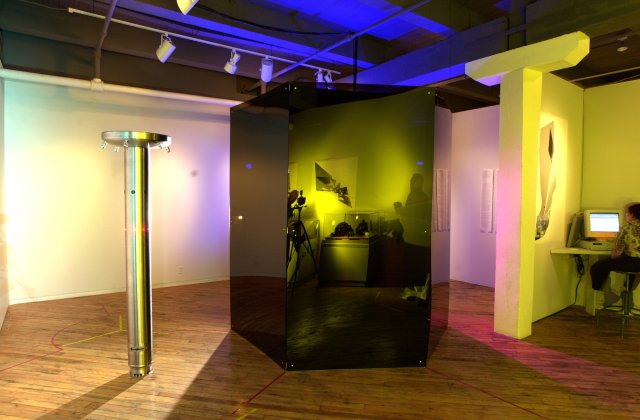
The central triage/observation room shown above
was built from six large sheets of very dark
smoked lexan. The hexagonal shape of this room is comprised of its
windows, each of which make up an entire wall. We cannot see into the
triage/observation room because it is dark inside the room, but we know that
if one or more persons were inside that they could very clearly see out into
the six hexagonal rooms that are to be built around it.
The locations where the walls of these six hexagonal rooms
are to be built are marked in red tape:
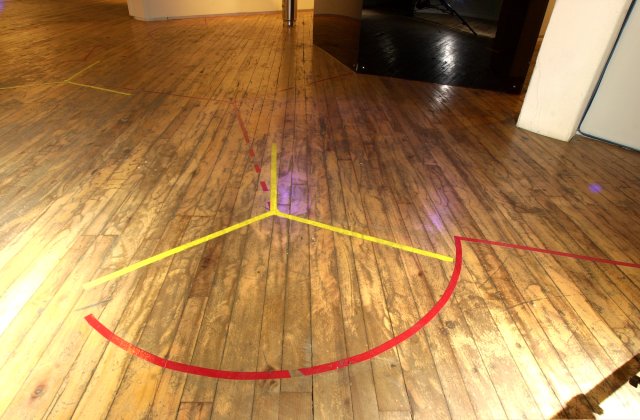
Here we see, for example, the entrance to women's stripdown and bagging room
showing, in yellow tape, where the rotors of a RotoGate high
security seven foot high turnstile will go.
Separate entrances for men and women are to be provided.
Three of the six rooms are for men, and the other three are for women.
The shiny tape on the hardwood floor,
and the choice of colors (red and yellow) is also reminiscent
of the markings on a
gymnasium
floor (thus calling to mind
the inevitable communal stripdown and
shower experience to follow).
A column shower is to be installed in each of the two shower rooms.
A Bradley six station
column shower has already been installed in the men's washdown room:
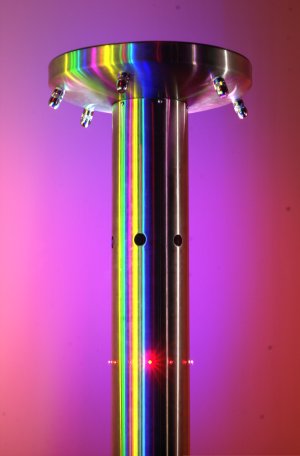
Version of above picture with color removed:
 .
.
The knobs and soap dishes have been removed from the column shower,
and the holes where these items once were have been replaced with a
machine vision system comprised of 12 laser diode body scanners together
with six round lexan viewing windows moulded into the inside of the
column. There are two laser diode body scanners for each of the
video sensors that are located at each of the six stations,
for purposes of photometric stereo imaging of the bodies
of the users of the column shower.
A set of six video motion detectors with
an Internet connected machine vision computer is to be placed inside each
of the two column showers in the men's and women's washdown rooms.
The system is sealed and completely watertight. Here is a closeup
picture of the six round watertight
viewports of the column shower currently in use in the men's washdown room:
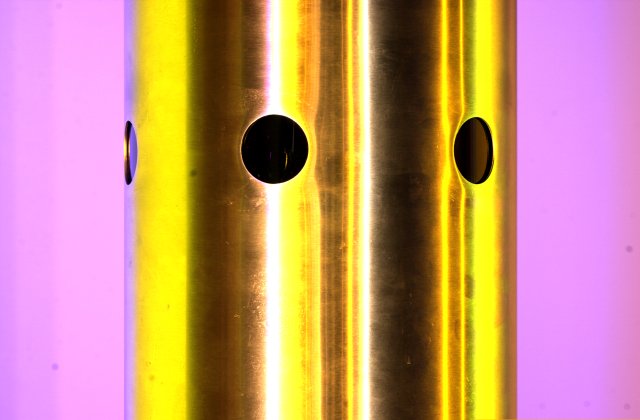
Three of the round smoked lexan viewing windows are visible here.
Up to six men can use this shower at the same time, but only the
number of stations actually being occupied will consume water.
Moreover, water is only consumed when a user is present.
Since there are no knobs or controls of any kind, there is no possibility
for deliberately destructive acts such as might otherwise happen
when users deliberately
(or accidentally) leave the water running.
Each of the six
nozzles face one side of the hexagonal shaped room to maximize
space usage and efficiency.
One of the six walls in this room is made entirely of smoked lexan,
so that triage personnel or decontamination officers can supervise the
decontamination process, whereas the six or fewer men in this room cannot see
the triage personnel or decontamination officers,
because of the darkness of the lexan (transmissivity is approximately 10
percent, meaning that transmissivity squared is approximately 1 percent,
as compared to roughly four percent reflectivity of the surface, such
that any visual perception of triage personnel or decontamination officers
will fall below a noise floor).
Typically, however, the triage personnel or decontamination officers
operate the facility remotely by way of six video cameras installed in the
triage/observation room. These six cameras are connected to six
television receivers at a remote location, as shown below:
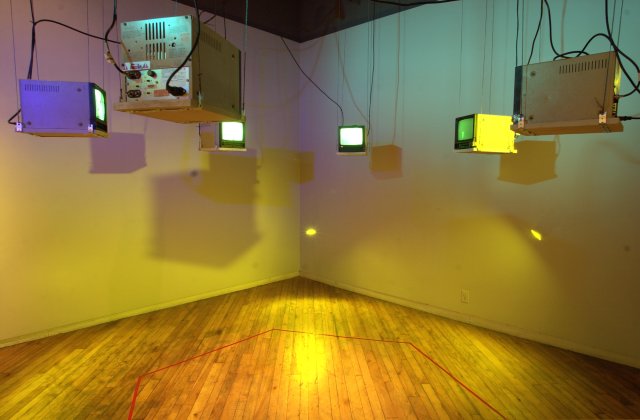
The six television receivers are arranged in the same hexagonal formation.
Six closed circuit television receivers
suspended from the ceiling display outputs
from each of the six decontamination rooms, as observed from
the triage room.
The four of the six screens that are visible here
correspond to (from left to right) the:
- men's stripdown and bagging room;
- men's washdown shower room;
- men's drying and examination room;
- women's drying and examination room.
Note also the hexagon made from red tape on the floor has the
same physical dimensions as the triage/observation room.
The display surface of each of the six television receivers
is aligned with and centered along the middle of
a corresponding side of the hexagon depicted on the floor in red tape.
Although the television displays shown here are of poor resolution:



(Here is the view from the men's decontamination/triage officer station,
during a Decon Drill, held at the 80 Spadina Ave. facility,
Thursday July 5th, 2001.)
The cameras are of very high quality and high resolution,
so that remote
triage personnel can clearly distinguish, for example, anthrax,
from dust or other dirt. Archived images can also be used as evidence
to prosecute those placing society at risk by failing to properly
undergo decontamination.
Thus high resolution sensors are to be used throughout the facility to
ensure satisfactory video quality:
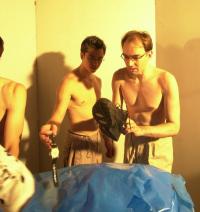
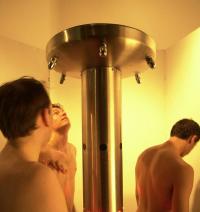
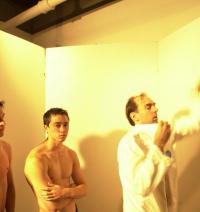
The above images illustrate the:
(1) Strip; (2) Wash; and (3) Cover procedure.
These three steps were practiced in the 2001 July 5th decon drill:
- In the
men's stripdown and bagging room,
patients remove clothing,
jewelry, eyeglasses, and other personal effects;
- In the men's washdown room,
a sensor operated column shower, adapted from a
Bradley column shower by EXISTech Corporation (EXISTech
replaced the six knobs
with six infrared sensors), patients wash to remove all traces of
nuclear, biological, or chemical contamination;
- In the men's examination room,
patients are remotely examined by way of
a video communications link in the triage/observation room.
Patients considered to be free of contamination are permitted to receive
Tyvek (TM) jumpsuits and are allowed to leave.
Download a Decon Drill training video.
The exhibit is an interplay or battle or war between individuals (wearing
computers or other cyborg technology) and the state or authority that tries to
strip its civilians of their clothing and their dignity.
The exhibit features the world's first true wearable computer, along with
other wearable computers from the last twenty years, together with the
mass decontamination facility that includes the most modern Internet connected
sensor operated showers with photometric stereo body-scanning machine vision
capability.
Return to mass decontamination facility
Why are we doing this? Here's some
excerpts from various government and
industry WWW sites.
Here is a 2001 April 1
article
outlining the general essence of this exhibit.
This exhibit was mentioned in an
article in the Toronto Star.
Curatorial Essay
by exhibition curator Kathleen Pirrie Adams, on a
site designed by Michelle Kasprzak, to be viewed in any browser.












